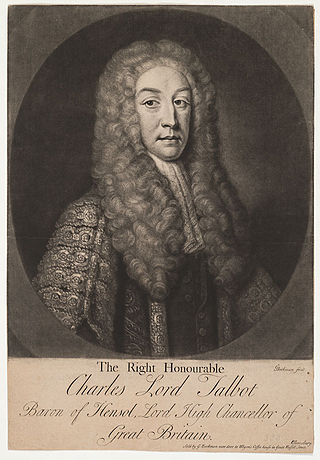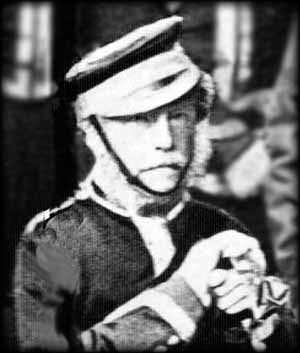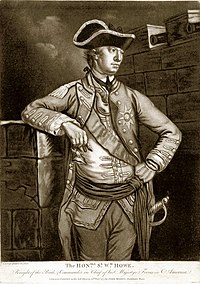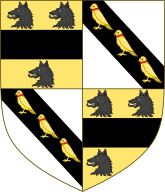The Peerage of the United Kingdom is one of the five Peerages in the United Kingdom. It comprises most peerages created in the United Kingdom of Great Britain and Ireland after the Acts of Union in 1801, when it replaced the Peerage of Great Britain. New peers continued to be created in the Peerage of Ireland until 1898

Baron Zouche is a title which has been created three times, all in the Peerage of England.

Earl Talbot is a title that has been created twice in the Peerage of Great Britain. This branch of the Talbot family descends from the Hon. Sir Gilbert Talbot, third son of John Talbot, 2nd Earl of Shrewsbury. His great-great-great-grandson, the Right Reverend William Talbot, was Bishop of Oxford, of Salisbury and of Durham. His eldest son Charles Talbot was a prominent lawyer and politician. In 1733, he was raised to the Peerage of Great Britain as Lord Talbot, Baron of Hensol, in the County of Glamorgan, and then served as Lord High Chancellor of Great Britain from 1733 to 1737.

Earl of Wilton, of Wilton Castle in the County of Herefordshire, is a title in the Peerage of the United Kingdom. It was created in 1801 for Thomas Egerton, 1st Baron Grey de Wilton, along with the subsidiary title of Viscount Grey de Wilton, also in the Peerage of the United Kingdom. Both titles were created with remainder to the second and all younger sons successively of his daughter Eleanor, wife of Robert Grosvenor, 1st Marquess of Westminster.

Earl of Bessborough is a title in the Peerage of Ireland. It was created in 1739 for Brabazon Ponsonby, 2nd Viscount Duncannon, who had previously represented Newtownards and County Kildare in the Irish House of Commons. In 1749, he was given the additional title of Baron Ponsonby of Sysonby, in the County of Leicester, in the Peerage of Great Britain, which entitled him to a seat in the British House of Lords. The titles Viscount Duncannon, of the fort of Duncannon in the County of Wexford, and Baron Bessborough, of Bessborough, Piltown, in the County of Kilkenny, had been created in the Peerage of Ireland in 1723 and 1721 respectively for Lord Bessborough's father William Ponsonby, who had earlier represented County Kilkenny in the Irish House of Commons.

Earl of Plymouth is a title that has been created three times: twice in the Peerage of England and once in the Peerage of the United Kingdom.

Viscount Scarsdale, of Scarsdale in Derbyshire, is a title in the Peerage of the United Kingdom. It was created in 1911 for the prominent Conservative politician and former Viceroy of India George Curzon, 1st Baron Curzon of Kedleston, who was created Earl Curzon of Kedleston at the same time and was later made Marquess Curzon of Kedleston.

Baron Ravensdale, of Ravensdale in the County of Derby, is a title in the Peerage of the United Kingdom. It was created in 1911 for the Conservative politician George Curzon, 1st Baron Curzon, of Kedleston, who had previously served as Viceroy of India.

Lord Chedworth, Baron of Chedworth, in the County of Gloucester, was a title in the Peerage of Great Britain. It was created on 12 May 1741 for John Howe, who had earlier represented Wiltshire in Parliament. In 1736 he had succeeded to the estates of his cousin Sir Richard Howe, 2nd Baronet. He was succeeded in the barony by his eldest son, John, the second Baron. He served as Lord-Lieutenant of Gloucestershire. He was childless and on his death in 1762 the title passed to his younger brother, Henry, the third Baron. He was unmarried and was succeeded by his nephew, John, the fourth Baron. He was the eldest surviving son of Reverend the Honourable Thomas Howe, younger son of the first Baron. He never married and the title became extinct on his death in 1804.

Richard William Penn Curzon-Howe, 1st Earl Howe, was a British peer and courtier.

George Augustus Frederick Louis Curzon-Howe, 2nd Earl Howe was a British peer and Conservative party politician.

Sir Nathaniel Curzon, 4th Baronet (1676–1758) of Kedleston Hall, Derbyshire was an English Tory politician who represented three constituencies in the 18th century.

Nathaniel Curzon, 1st Baron Scarsdale of Kedleston Hall, Derbyshire was an English Tory politician and peer.

Nathaniel Curzon, 2nd Baron Scarsdale was an English Tory politician and peer.

Assheton Curzon, 1st Viscount Curzon, styled Lord Curzon between 1794 and 1802, was a British Tory politician.
The Hon. Montagu Curzon was a British soldier and Conservative politician.

Scrope Howe, 1st Viscount Howe of Langar Hall, Nottinghamshire, was an English politician. He was the Member of Parliament (MP) for Nottinghamshire from 1673 to 1685 and January 1689 to 1691, and from 1710 to 1713.

The Honourable Robert Curzon, of Parham Park, Sussex, was a long-standing British Member of Parliament.
Alfred Nathaniel Holden Curzon, 4th Baron Curzon,, was a British aristocrat and clergyman. He was the father of George Curzon, 1st Marquess Curzon of Kedleston, who was the Conservative Viceroy of India and British Foreign Secretary.

Richard Nathaniel Curzon, 2nd Viscount Scarsdale was an English peer and landowner, a member of the House of Lords for more than fifty years.



















